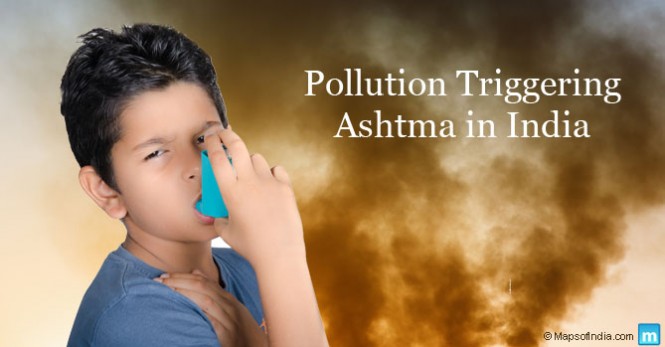 Recently, a nation-wide survey called ‘Breath Blue 15’ concluded that the lung health of children in metropolitan cities of India is poor. In all, 2000 children in the age group of 8-14 years were screened for lung health status. 40% of children in Delhi were found to have ratings of ‘bad’ to ‘poor’ lung health, while Bengaluru followed closely with 36%, Kolkata with 35%, and Mumbai with 27%. It is no coincidence that these cities are some of the most polluted cities in the world. Air pollution levels in these cities is at an all-time high, owing to multiple factors such as overcrowding, mass immigration, rise in vehicular population and consequent smoke emission and industrial activity.
Recently, a nation-wide survey called ‘Breath Blue 15’ concluded that the lung health of children in metropolitan cities of India is poor. In all, 2000 children in the age group of 8-14 years were screened for lung health status. 40% of children in Delhi were found to have ratings of ‘bad’ to ‘poor’ lung health, while Bengaluru followed closely with 36%, Kolkata with 35%, and Mumbai with 27%. It is no coincidence that these cities are some of the most polluted cities in the world. Air pollution levels in these cities is at an all-time high, owing to multiple factors such as overcrowding, mass immigration, rise in vehicular population and consequent smoke emission and industrial activity.
Asthma is a chronic non-communicable condition that affects the lungs, and can be a debilitating condition if it is not controlled well. With World Asthma Day being observed on the first Tuesday of May and the entire month being observed as the Asthma Awareness Month, it is time that this condition gets the due attention that it deserves from urban planners and the general public alike. Asthma causes breathlessness, wheezing, respiratory insufficiency, and tightness. It is an allergic response to certain triggering agents, allergens, which is generally dust, pollens, cigarette smoke, pollution, viral infection and other unknown agents.
The World Health Organisation estimates that 235 million people suffer from asthma across the world, and no country, whether developed or developing, is exempt from the public health burden due to the condition. It is a major non-communicable disease among children, and mothers who smoke, or are exposed to passive smoking during pregnancy. They are likely to give birth to asthma-prone children. While studies have not conclusively proved that air pollution can cause new cases of asthma, pre-existing cases are certainly known to worsen when exposed to air pollution. Asthma, along with the other related respiratory condition; chronic obstructive pulmonary disease (COPD), is on the rise across the country, especially in urban areas.
Treatment and Prevention of Asthma
Treatment of asthma involves two strategies; relieving the symptoms and preventing further attacks. ‘Relievers’, such as salbutamol, act by reducing the breathlessness and wheezing. On the other hand, ‘preventers’, such as steroids, act by reducing the inflammation in the airways of the lungs. Both of these can be taken in the form of inhalers, which administer the medication directly into the respiratory passage. However, in severe cases, oral and intravenous agents may be required to reduce the symptoms of the condition.
If you are asthmatic, and develop any of the following problems, it means that the asthma is not under control, and may require urgent expert care:
• If you are using more and more of the ‘relievers’ to reduce the symptoms
• If you feel breathless or have coughing in the middle of the night, or after trivial physical activities
• If you are losing out on socializing or absenting yourself from work due to the symptoms
• In severe cases, if the symptoms are not relieved even after five minutes of repeated inhaler therapy; or if you are unable to talk due to breathlessness; or if your lips turn blue
A lot has to be done to reduce the burden of asthma in India. Cities have to be decongested and rapid urbanization has to be checked. Vehicular emissions have to be measured, and erring vehicles should be kept off the roads. Deforestation and cutting of trees in urban areas have to be reduced; every area in a city should have a green space. Smoking has to be reduced through legislation and public health messages.
More than legislation and policy making, people should be disciplined enough to make sure that they are not contributing to air pollution themselves. Switching off engines of vehicles at traffic junctions, using public transport, and car-pooling may be simple, but effective ways of contributing to the environmental cause. It is important to remember that by causing air pollution, we are affecting the health and future of our own children.
Related Information:
What is Anthrax ? : Symptoms, Treatment, Prevention Measures
Rotavirus Vaccine Launched in India
Is India Prepared for Zika Virus: Guidelines, Symptoms, Diagnosis & Treatment
Is India Close To Developing The Zika Virus Vaccine?
Genital Tuberculosis: Causes, Symptoms and Remedy
Communicable Diseases Prevention Measures
Organ Donation in India
Health & Fitness Gadgets
Hepatitis B in India: Guidelines for Prevention, Symptoms, Causes, Risks & Treatment
Amendments Proposed in Anti-smoking Law in India
The 10 Ways to Quit Smoking
How Useful are E-cigarettes?
Tobacco – The Leading Cause of Illnesses
How to Stay Healthy During Monsoons? Do’s and Don’ts
Green Tea: Types, Benefits and Side Effects
Japanese Encephalitis in India – Guidelines for Prevention, Control & Symptoms
Swine Flu Continues to Ravage India
Ebola Virus Outbreak – Is India Prepared?
India To Be Certified As A Polio-free Nation By WHO
Non-Communicable Diseases – Take Care, Before It’s Late
Swine Flu: What You Need to Know and Do
Prevention of Heart Attack and Other Related Heart Diseases
Leprosy – Causes, preventions and eradication programme
Prevalence of Diabetes in India
Can Delhi Handle an Ebola Outbreak
The Fever : Vaccination Still An Elusive Proposal
A Reality Check on State of Mental Health in India
Sharp rise in non polio Acute Flaccid Paralysis after polio-free status
How to Prevent Hair Loss in 10 Tested Ways?




